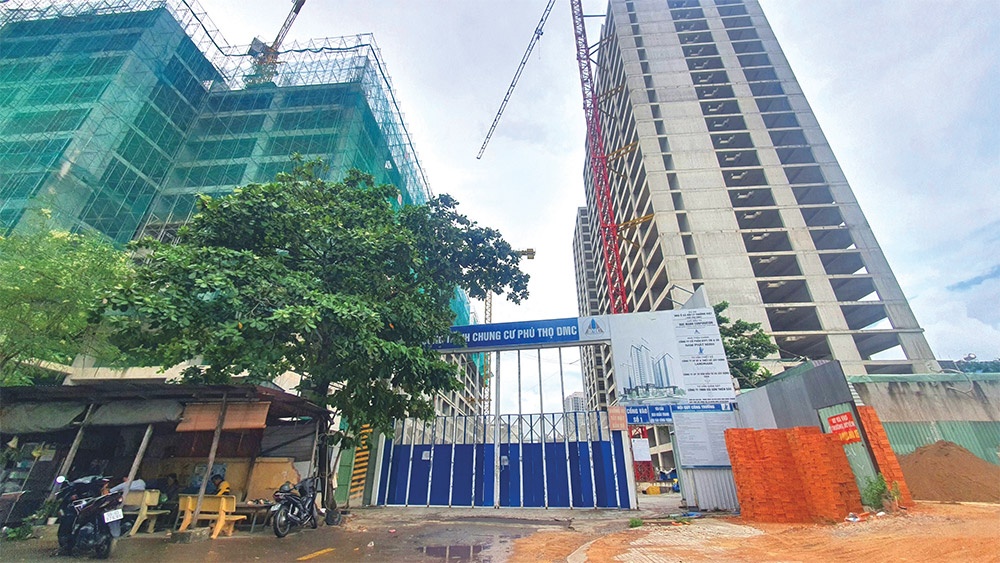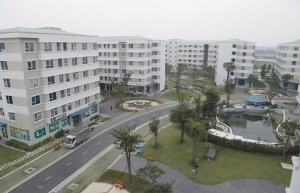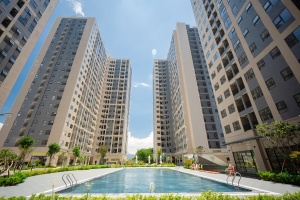More social housing among urgent acts in construction
 |
| Dozens of new commercial housing schemes in Vietnam’s biggest cities were completed or began construction last year, Photo: Le Toan |
A report from the ministry (MoC) in January said that in the face of continuing global and domestic complexities, 2024 was likely to be another challenging year.
Although the construction sector bagged several achievements in 2023, it was hit by common issues facing the country, as well as chronic unsolved problems of the sector that have existed for many years.
The sector envisages growing from 6.5-7 per cent in 2024 compared to 7.3-7.5 per cent level in 2023, with the urbanisation rate reaching 43.7 per cent nationwide; urban access to safe water in a centralised water supply system surpassing 97 per cent; and per capita average flooring area exceeding 26.5 sq.m throughout the country. Cement production is set at about 100 million tonnes.
The report reads that in 2023, the urbanisation rate reached 53.9 per cent nationwide; around 96 per cent of urban dwellers getting access to safe water through centralised water supply system; average per capita flooring area amounting to 26.2sq.m nationwide; and entire administrative procedures were processed through national public services portal.
In its 2024 agenda, the MoC shall continue to focus on perfecting legal institutions, focusing on completing the Law on Urban and Rural Planning, and relevant decrees guiding the Law on Housing and the Law on Real Estate Business.
Regarding housing and real estate, MoC Minister Nguyen Thanh Nghi proposes focusing on housing development, especially social housing; expediting the plan on building one million social housing units, along with enforcing government Resolution No.33/NQ-CP, presenting a raft of solutions to sustainably spur real estate market development.
Localities must review and make a list of projects facing impediments to work on remedies and task assignment to overcome difficulties.
Hoang Hai, director general of the MoC’s Department of Housing and Real Estate Market Management, however, stressed the need to keep close eyes on the market situation and continue expediting strong rectification measures going forward.
So as to troubleshoot urgent demands for social housing supply and accommodation for workers in industrial zones (IZs), the MoC is attempting to build at least one million social housing units for low-incomers and IZ workers by 2030.
The project aims to provide affordable housing for low and medium-income families in urban areas, as well as workers at IZs and export processing zones across the country.
In light of the scheme, by 2030 more than one million housing units shall be completed by localities nationwide, in which about 428,000 units will be completed before 2025, and the remaining units before the end of the decade.
According to reports by localities, as of now 475 social housing projects of around 432,700 units have been either completed or are in the development pipeline throughout the country.
The MoC has been teaming up with relevant management agencies and localities to expedite the project, such as enacting documents to urge localities to accelerate execution, and presiding a national conference on the project implementation.
In respect of the $5.06 billion preferential social housing credit package, as of now 23 localities have made public a wish-list of 54 projects eligible to borrow under the scheme, with estimated lending amount surpassing $1 billion. Until now, about $6.04 million has been disbursed.
According to the MoC, the real estate market stagnated in 2023, although the second half of the year saw marked improvements with positive signals compared to the first half. Transactions in diverse segments such as land plots and apartment units rebounded, along with an ever-burgeoning new supply from new projects.
By the end of the third quarter of last year, the commercial housing segment saw 42 projects coming on stream with 15,966 housing units, equal to 46.15 per cent compared to 2022; social housing segment eyed the completion of five projects with a scale of 850 units; and resort and mixed-use complex segment saw the completion of 17 projects, equal to 56.67 per cent of 2022.
In terms of pricing, according to summary reports and survey results from localities and market research organisations, apartment prices have continually increased due to supply scarcity. Meanwhile, the price of low-rise housing and some other real estate segments decreased from 10 per cent to 20 per cent, depending on location.
| Nguyen Van Sinh, deputy Minister of Construction
The doldrums of the real estate market have taken a bite from the performance of businesses in diverse segments, including real estate, developers and building-material makers. Delays in construction and escalating input costs have put building materials makers in tight conditions, facing slow consumption with mounting inventories, and the stalling of a slew of production lines. As such, many business metrics fell compared to 2022 performance, particularly profits, with building material production sinking in the red. The gross production and business value of the segment came in at $2.42 billion, equal to 85 per cent compared to one year ago, and 88 per cent of the full-year projection. The segment’s total revenue amounted to $2.27 billion, equal to 84 per cent compared to one year ago and 88 per cent of the full-year plan. Pre-tax profit saw a sharp decline, falling to around $58.2 million, equal to 34 per cent of that one year ago and 88 per cent of the full-year plan. In 2024, the MoC will continue to work on simplifying investment and business conditions in diverse fields of construction, and perfecting execution and control processes to effectively meet the requirements for project evaluation, design, and capacity assessment of organisations and individuals. Further work involves reviewing and supplementing construction norms for key projects of the transport industry, investment capital ratio, and general construction pricing for the management of investment construction costs. Keeping a close eye on the building material market situation is critical to ensure sufficient supply, particularly of major materials, along with presenting measures for effective management of building materials’ investment development when the materials development planning becomes expired. The 2024 agenda also comprises continuing to handle difficulties in investment construction management of two new projects: Bach Mai Hospital and Viet Duc Hospital’s facility 2 in Ha Nam province; building the Ministry of Foreign Affairs’ headquarters; metro line construction in Hanoi and Ho Chi Minh City; and key projects of the transport, industry, and trade sectors; alongside urging businesses to focus on finalising unfinished projects, especially social housing projects, to boost liquidity. |
 | HCM City to build 35,000 social housing apartments in 2021-2025 The southern economic hub of Ho Chi Minh City is striving to build 35,000 social housing apartments by 2025, equivalent to 2.5 million square metres of floor space, said the municipal People's Committee. |
 | Dulux Professional backs quality social housing projects with sustainable solutions Dulux Professional from AkzoNobel, a leading company in paints and coatings, has provided premium exterior products for The Ori Garden Danang, invested in by Saigon Danang Investment Corporation (SDN), with the aim of bringing high-quality and sustainable social housing to thousands of families. |
What the stars mean:
★ Poor ★ ★ Promising ★★★ Good ★★★★ Very good ★★★★★ Exceptional
Related Contents
Latest News
More News
- Sun Group breaks ground on $2 billion Van Don casino complex (December 19, 2025 | 18:14)
- Rare, beautiful, sustainable: the mark of iconic real estate (December 19, 2025 | 08:00)
- Owner-occupied housing stabilises, paving the way for new growth cycle (December 18, 2025 | 17:04)
- Unlocking urban potential of smart cities (December 18, 2025 | 16:50)
- Green finance offers 'passport' for Vietnamese construction, building materials firms (December 15, 2025 | 08:00)
- Gamuda Land commit long-term investment (December 12, 2025 | 11:49)
- HITC ties up with Evolution to develop AI and hyperscale data centres in Vietnam (December 11, 2025 | 12:09)
- Real estate deals boom via high-profile names (December 08, 2025 | 11:32)
- Industrial segment shaped by M&As (December 08, 2025 | 08:00)
- The Privé sets the benchmark for luxury real estate (December 05, 2025 | 08:28)


 Tag:
Tag:



















 Mobile Version
Mobile Version